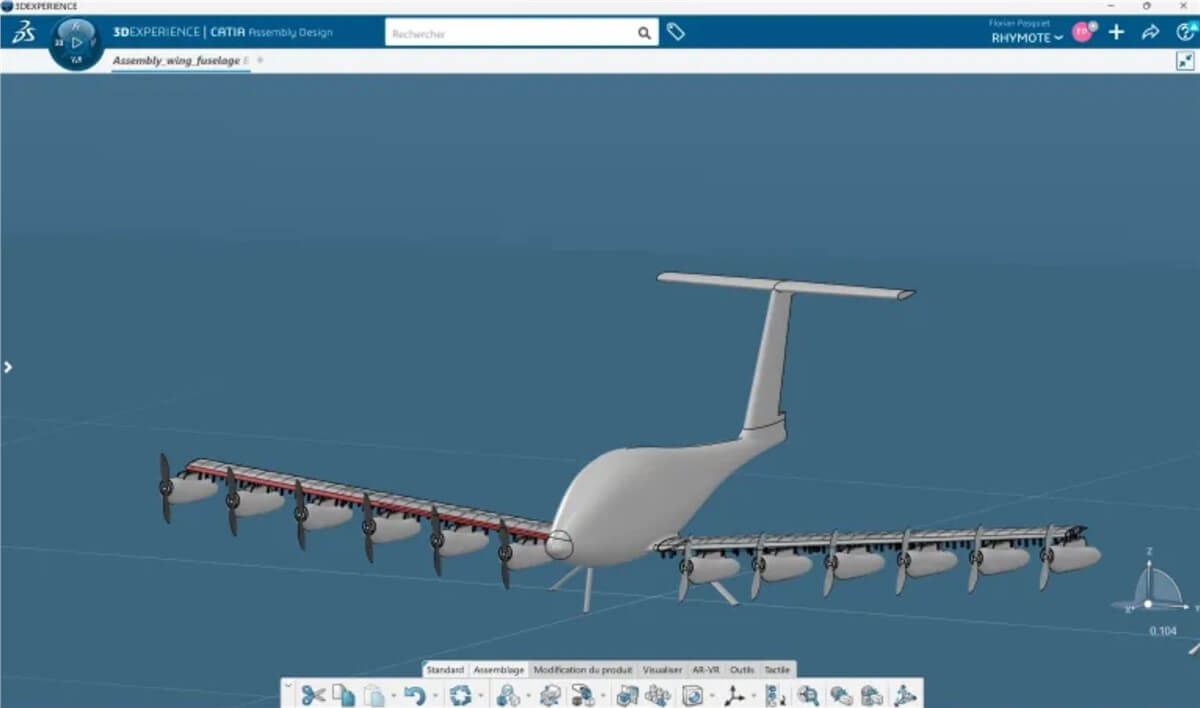French hydrogen-based aviation startup Blue Spiriti Aero is using Dassault Systèmes' 3DEXPERIENCE platform in the cloud to accelerate the development of the "Dragon Fly" - a light, hydrogen-powered electric aircraft containing multiple separate engines and propellers for redundancy and safety

The French aviation start-up Blue Spirit Aero, based on hydrogen propulsion, uses Dassault Systèmes' 3DEXPERIENCE platform in the cloud to accelerate the development of a hydrogen-powered electric aircraft, as well as advance and obtain official approval for clean and accessible aviation.
The aircraft developed by the company is called "Dragon-Fly", built on electric propulsion technology developed by Blue Spirit Aero.
This technology provides clean operation, and the company aims to bring it to approval and active service as early as 2026.
The BSA Dragonfly uses multiple electric motors and propellers along the leading edge of the wing. This is a principle known as distributed electric propulsion and its advantage is that if one or even three or four engines stop, the aircraft will lose performance but still fly. Each electric motor and accessory is independent, so it can be replaced quickly.
David Yanchkovic, Head of Aerodynamics and Performance, is currently conducting the aircraft's wind tunnel test procedure to verify the aerodynamic characteristics of the Distributed Electric Propulsion (DEP) architecture. Florian Pesquit conducts the test campaign of the flying mockup – that is, an enlarged radio-controlled aircraft – to verify the dynamic performance.
By starting the design from scratch, the engineers can change some of the features. For example, the hydrogen fuel tanks are outside the body of the aircraft because of the inevitable leakage which is a basic problem with hydrogen. This reduces the risk of fire - and will help in the certification process.
BSA's target market for the Dragonfly is flight schools that typically operate from one airport where hydrogen fueling infrastructure can be installed. They are aiming for the first flying prototype by the end of 2024 with entry into service by the end of 2026.
Blue Spirit Aero was founded by current CEO Olivier Sabin in mid-2020, is partially funded by grants from the Aerospace Valley and is looking for investors.
XNUMXD planning in a few months
Blue Spirit Aero used Dassault Systèmes' industrial solution Reinvent the Sky, based on the 3DEXPERIENCE platform, and within just a few months was able to complete a full XNUMXD design of its aircraft, as well as examine and validate its operation in terms of structure, propulsion and aerodynamics.
The platform, with its virtual environment and cloud concept, allowed the startup developers to optimize the work process and the communication between the experts in different disciplines and geographical locations, and in addition, to optimize the decision-making process.
"The 3DEXPERIENCE platform is the basic technology in the aviation industry" said Olivier Sabin, the founder and president of Blue Spirit Aero.
We rely only on this platform for all aspects of our product development from the idea to the implementation and thus we give additional validity and reliability to every step and every breakthrough in development. We can show potential investors, partners, employees, suppliers, customers and regulators hydrogen propulsion solutions that are developed with the same software used by the most technologically advanced commercial airlines.

4 תגובות
Adding engines does not necessarily contribute to safety. The chances of engine failure *increase* the more engines there are. Therefore, excess power is needed for the aircraft to fly safely with one (or more) faulty engines.
This issue is especially critical during the take-off phase, which is the most dangerous part of the flight anyway.
It may be better to have a few engines and invest more in their reliability.
There is no way that a hydrogen-powered vehicle or a hydrogen-powered airplane will get a license. And if they accept, with the first one that explodes due to a small leak or in an accident, the license will be revoked. I once had to drive a hydrogen-powered vehicle that was an experiment by Ford, and being on the road with five or six hydrogen tanks each 20 cm in diameter and about one and a half meters high, filled with hydrogen compressed at 200 atmospheres filled me with terror. What calmed me down was the thought that if there was an accident, everything would be over in a few seconds....
And so I entered the startup's website to extract as many details as possible that were not in Dassault's announcement that was intended for the financial press.
A great advertisement for the Dassault company, nothing unusual from a design point of view is described here. Every self-respecting engineering company today works with XNUMXD planning tools, some of them indeed in the cloud.
And regarding the number of motors, they forgot to mention that the efficiency of electric motors drops from over 80% to less than 60 when you increase to large loads (for example when you want to fly a plane). So the usefulness of this plane will not necessarily justify the use of hydrogen. I wish them success in dealing with the regulations.